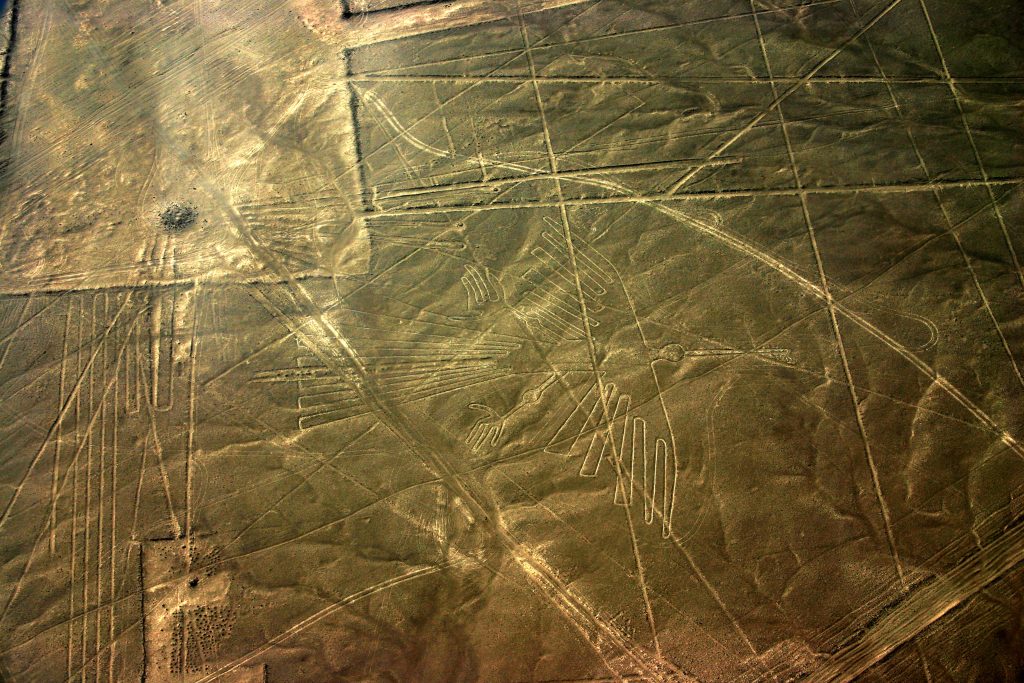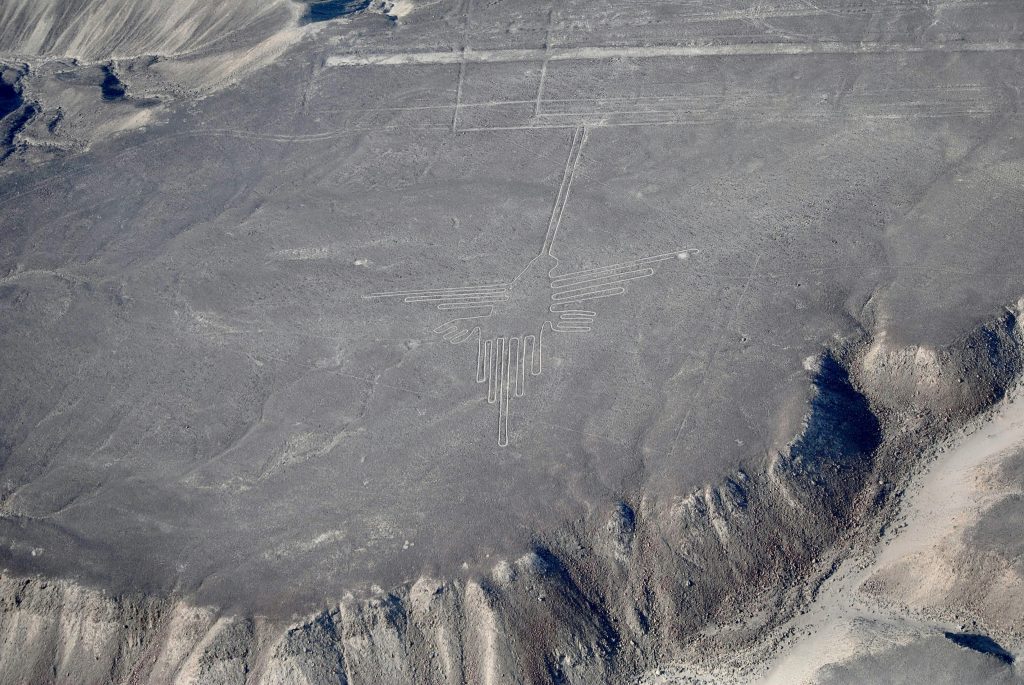The vast, arid plains of southwestern Peru hold one of the world’s most enduring archaeological mysteries: the Nazca Lines. These colossal geoglyphs, etched into the desert floor, depict everything from perfectly straight lines stretching for miles to intricate animal figures and geometric shapes. For decades, they’ve captivated imaginations, fueled outlandish theories, and challenged scientists to unlock their secrets.
But what exactly are these mysterious markings, and why did an ancient civilization dedicate such immense effort to create them?
A Glimpse from Above: The Discovery
The Nazca Lines remained largely unnoticed by the wider world until the advent of commercial aviation in the 1930s. From the ground, many of the lines are barely discernible, blending into the stony desert. However, pilots and passengers flying over the region began to witness an astonishing sight: hundreds of lines radiating from central points, geometric patterns, and giant figures of animals like hummingbirds, monkeys, and spiders, all visible only from significant altitude.
Initial encounters, however, were far less dramatic. In September 1926, archaeologists Toribio Mejía Xesspe and Alfred Kroeber surveyed the rocky slopes near Nazca, intending to examine a nearby burial ground. They briefly paused, overlooking the flat, gravelly desert, and noticed a series of long, straight lines. Both researchers dismissed them as an ancient irrigation system, giving them little further thought. Little did they know, they had stumbled upon a wonder that would perplex generations.
How Were They Made? A Simple Yet Enduring Method
Upon closer inspection, archaeologists realized that the lines and figures were created by simply removing the dark, oxidized pebbles that cover the desert surface, exposing the lighter, yellowish-white sand beneath. This simple yet brilliant technique ensured the longevity of the geoglyphs. The Nazca Desert is one of the driest places on Earth, receiving barely 20 minutes of rain annually, and is remarkably wind-free. These extreme conditions have allowed the Nazca Lines to remain remarkably preserved for centuries, even millennia, with pottery fragments found near some lines suggesting they are over 2,000 years old.
From Ancient Astronauts to Astronomical Calendars: Early Theories
The sheer scale and ground-level incomprehensibility of the Nazca Lines naturally led to a flurry of speculative theories. How could ancient people have created designs only visible from the sky?
One of the most sensational and widely popularized theories came from Erich von Däniken’s best-selling book Chariots of the Gods? He proposed that the lines were landing strips for extraterrestrial spacecraft and the figures marked landing sites. While captivating, this “ancient astronaut” theory was largely based on superficial resemblances and lacked any scientific basis.
Another early idea suggested that the ancient Nazca people might have possessed the ability to fly, perhaps using rudimentary gliders or hot-air balloons. While intriguing, evidence for such technology remains absent.
The first serious scientific inquiry into the Nazca Lines began in 1941 when American historian Paul Kosok visited the desert. Like others, Kosok sought answers by looking to the sky. His moment of revelation came while observing the sunset: he noticed the sun perfectly aligned with the end of a long line. It was June 22nd, the winter solstice, the shortest day of the year. Kosok exclaimed, “We immediately realized with great joy that we had apparently found the key to the riddle! Surely, the ancient Nazca people had etched this line to mark the winter solstice. If so, it is highly likely that the other markings are in some way related to astronomical and other related activities.”
Kosok, needing to depart, enlisted the help of Maria Reiche, a German-born mathematics teacher in Lima. By the end of the year, Reiche had discovered twelve more lines that aligned with either the winter or summer solstices. Kosok and Reiche concluded that the desert was the “largest astronomy book in the world,” acting as a colossal calendar marking important astronomical events.

Skepticism and Systematic Analysis
Critics of Kosok and Reiche argued that with so many lines extending in so many directions, it was merely coincidence that some aligned with the sun. A more systematic approach was needed.
Enter Gerald Hawkins, an astronomer who arrived in Peru in 1968. Hawkins, known for his computer-aided analysis of Stonehenge’s astronomical alignments, set out to bring rigor to the Nazca mystery. His team meticulously mapped the lines from aerial photographs, then fed data on the positions of the sun, moon, and various stars into a computer, accounting for astronomical shifts over two millennia. From 186 chosen lines in one section, Hawkins found that only 39 aligned with astronomical positions. This was a significant disappointment; statistically, about 19 lines could be expected to align by chance alone. Over 80% of the chosen lines appeared to run in entirely random directions. Hawkins, despite being a proponent of astronomical theories for Stonehenge, concluded that “the sun-moon-star calendar theory for Nazca was computer-denied.”
A More Complex Picture: Diverse Purposes Over Time
The mystery deepened. If not primarily an astronomical calendar, what else could the lines be?
In the early 1980s, Canadian archaeologist Persis Clarkson began analyzing pottery shards found near the lines. Her astonishing conclusion was that some shards (especially near the animal figures) dated between 200 BCE and 200 CE, while others matched pottery styles from nearly a thousand years later. This suggested that the Nazca Lines were not created at one single time but over a long period by different groups, implying they might have served a variety of purposes. As anthropologist Anthony Aveni put it, perhaps the “blackboard” was not for one geometry lesson, but many.
Later theories, emerging in the late 1980s, consistently revolved around water, an incredibly precious commodity in the arid desert. Anthropologist Johan Reinhard suggested that some lines might have connected specific points in the irrigation system with places of worship, possibly as part of fertility rituals. The numerous bird designs took on new meaning, as modern Nazca farmers interpret the sighting of herons, pelicans, or condors as signs of rain. Perhaps drawing these birds and other animals was a plea for rainfall.
Anthropologists Aveni and Helene Silverman noted that many lines correlated with geographical features. Most lines flowed in the same direction that water would run after a rare desert rainstorm, and many pointed to nearby water channels where water once flowed. While not irrigation ditches themselves (they were too shallow), Aveni and Silverman agreed with Reinhard on a ritualistic connection between the lines and water.
Aveni also collaborated with Tom Zuidema, an expert on the Inca people. Zuidema realized that Cusco, the Inca capital, was designed as a network of straight lines radiating from the Temple of the Sun. This radial design held significant religious and social meaning for the Inca. Zuidema and Aveni concluded that the radial design of many Nazca desert lines suggested similar beliefs among the Nazca people.
Gary Urton, another anthropologist, found parallels in the practices of contemporary villagers near Cusco. He described how, during certain celebrations, the people of Pacaritambo sweep long, elevated paths of the public square. It was not a stretch for Urton to imagine the ancient Nazca people performing a similar ritual on the desert lines.
The Legacy of Maria Reiche and Evolving Understanding
Maria Reiche continued to live in Nazca, becoming not only an expert on the lines but also their dedicated guardian. After von Däniken’s work turned Nazca into a tourist destination, Reiche used her limited resources to hire security guards. Even as an elderly woman, she would patrol the desert in her wheelchair, shooing away tourists if she feared they might damage the lines. She became a national heroine in Nazca.
While her dedication was immense, it also led to some controversy in the early 1990s, when her guards temporarily prevented other researchers like Clarkson and Urton from working, accusing them of theft and damage. Critics suggested Reiche might have been trying to protect her own astronomical theory and her lines.
However, Reiche, who passed away in 1998 at 95, would have found some solace in the most recent astronomical analyses by Aveni and British astronomer Clive Ruggles. Like Hawkins, they found that celestial alignments could not account for the majority of Nazca Lines. Yet, unlike Hawkins, they concluded there were too many astronomical alignments for all of them to be mere coincidences. Aveni also noted that some of the radial lines in Cusco aligned with the sun, moon, and stars, leading him to conclude that astronomy did play a role in Nazca, though a much smaller one than Kosok or Reiche had envisioned.

No Single Answer
For those who crave a singular, definitive explanation for the Nazca Lines mystery, the overlapping range of theories—astronomical, agricultural, religious—can be unsatisfying. But the reality is far more complex.
It is highly unlikely that one single explanation can account for all the lines and figures. Instead, recent findings by Aveni, Silverman, Urton, Zuidema, and others share a common thread: they seek connections between the Nazca people and other Peruvian cultures, both ancient and modern. These connections have been crucial in understanding the Nazca Lines within their broader cultural context.
The Nazca Lines are often called “one of the wonders of the ancient world,” suggesting they are so remarkable that they are difficult to understand within the context of anything else known about South American archaeology. However, for the latest generation of archaeologists, anthropologists, and historians of Nazca, the opposite is true: if we are to understand the lines at all, it can only be done within the rich tapestry of their world. The Nazca Lines are not just a mystery; they are a window into the ingenious minds and complex beliefs of an ancient civilization.

